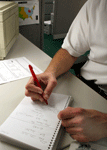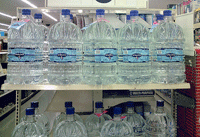Water Softener & Filter Salesman – Part 2
Water softener & filter salesman tactics exposed in detail. Including the type of “Survey sheets” that many of them use to convince you to buy overpriced water treatment systems for $6000 to $10,000.
Questions on to the survey sheet
- How much do you spend on soaps, lotions & cleaners? This is usually the biggest money finder and very easy to prove because of the demonstrations given in the house. This comes out to around $100 a month.
- How much do you spend on bottled water? This is at least $10 at a minimum.
- How much do you spend on heating your water? This is usually around $30. This is a hard number to come up with for most because it’s tough to put a dollar amount on the water you heat, but this adds to the savings.
- How much do you spend on any type of clothing or really anything that has fabric in a year? This is usually around $500. Another tough one to prove, but the in-house demonstrations make believers out of the customer and this adds to the savings.
- How much it would cost if you had to replace all the plumbing and fixtures in the house? Some representatives will keep it simple and more believable by asking about how many washing machines, hot water tanks, dishwashers and faucets they’ll replace in the next 25 years. This usually comes out to $5000. (Divide the total by 25 years)
The tests and demonstrations
Soap and cleaner tests
There are many cleaning demonstrations. And one of the most powerful is the beaker test that we went over in our Part 1 blog, check it out if you haven’t already. This one is very convincing. They have two beakers, one with the filtered water and a second with the raw water. Then they add pure soap to the beakers, one drop at a time. And then they add about 3 drops to each beaker and shake them up. The filtered water erupts with suds while the raw water just has soap scum. They continue to add drops to the raw water beaker, still no suds appear, just more soap scum.
Around 30 drops or more, suds may appear. But the water is gray and simply doesn’t look as good as the filtered water. Which is still full of suds and crystal clear. They say each drop of soap used represents $1, one box of detergent or whatever clever way they decide to present it. But the savings remain the same. It will look like it took $3 worth of soap with the filtered water compared to the $30 worth of soap with the raw water. That’s a difference of $27 which is a 90% savings (even lowball it and used 80% for our chart). After seeing the demonstrations how can the customer NOT agree they’d be saving that much?
Bottled water tests
The potential customer is given a glass of filtered water and a glass of raw water. They drink the filtered water first. Then they are told to swish it around like it was a wine tasting. Now, the salesperson hands the customer the raw water with a face that says, “I can’t believe they’re going to drinking this”. Once the potential customer has tried both. They obviously choose the filtered water. Because unfiltered water can have a chlorine taste (city water). Or other tastes and smells (well water). Who would buy bottled water if they had this filtered water coming out of their tap?
Precipitation tests
When you first sit down to do the tests. Normally the salesperson will advise you that this test will go first. Because it takes the longest to work. There will be two large test tubes filled with, filtered water and your raw water. Two precipitation solutions go into the tubes. The first will chemically react with substances in the water making them solid. The second solution gives the the new solid particles color so they can be seen. The tubes are then set aside. Now the sales person will go through the other tests we mentioned above.
When they are done, they will go back to the precipitation test and in most cases, the bottom of the raw water tube is filled with junk. They’ll use this visual to reinforce the benefits their system in respect to drinking the water and using the water for hot water tanks. Who would want to drink water with THAT in it (even though that what you see is usually just harmless minerals)? Or, if you were heating the unfiltered water it would seem you had to heat through a brick while the filtered water is crystal clear.
The salesman’s hand book
Most salespeople will have a handbook about their company to go over with you. And it will have neat facts about water. And studies backing the saving potential of their system. Each page in this handbook relates to one of the tests that were preformed in your home. This we refer to as the “dog & pony show”. Slick salespeople get the potential customer to commit to agreeing with what is on the each page. This eliminates certain objections at the time the price is given later
Water Softener & Filter Salesman Proof of savings
Now it’s time to see the savings. The sales person will fill out a chart with your answers to the questions. They make sure they have 100% commitment in the number given and go back to the in-home demonstrations to get it, if necessary. The chart (below) will show the categories, percentage of savings, current cost, potential savings and cost with the system installed. Most salespeople will not include the clothing and plumbing categories, they save these to help close the deal with statements like, “we didn’t even add the clothing and plumbing savings”, and you agreed that those savings existed during the demonstrations. Starting to see how it works?
Common Chart Used by in-home salespeople
| Category | Savings | Currently Spending | Savings | Spend with system installed |
| Soaps and Cleaners | 80% | $100 | $80 | $20 |
| Bottled Water | 100% | $10 | $10 | $ 0 |
| Hot water Tank | 33% | $30 | $9 | $21 |
*Monthly savings chart with two categories purposely left off, some will include them if they really need to find all the possible savings to convince the customer they can afford the system.
The salesperson will explain that their system will only cost you about a dollar a day, even though the payments will be around $125 to $175 a month. Confusing? It won’t be next week when I go over the chart in detail and show you how it is used to close the deal…
-Water Filtration Wizard




Leave a Reply